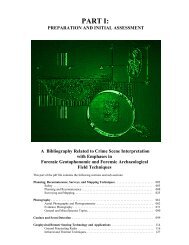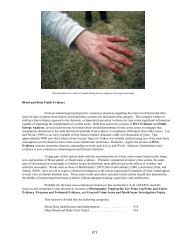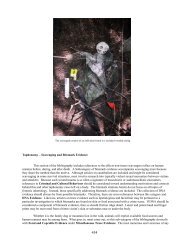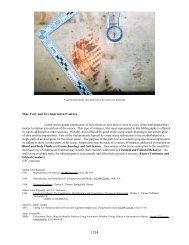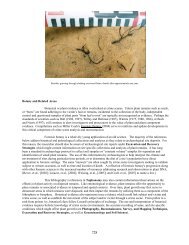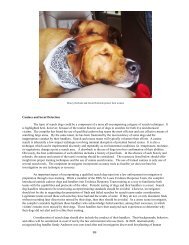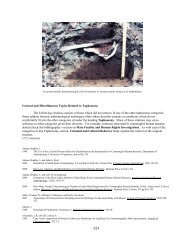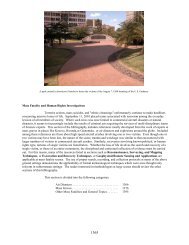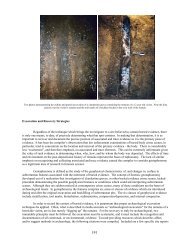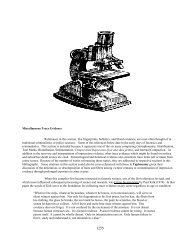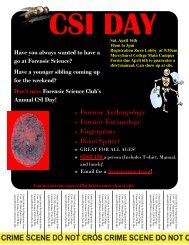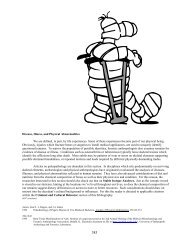- Page 1 and 2:
PART V: MISCELLANEOUS EVIDENCE A Bi
- Page 3 and 4:
other categories in this bibliograp
- Page 5 and 6:
1980 Chemical Reagents for the Deve
- Page 7 and 8:
2003a SWGFAST Glossary www.theiai.o
- Page 9 and 10:
Azoury, M., A. Zamir, C. Oz, and S.
- Page 11 and 12:
2002 Fingerprint Identification: Fe
- Page 13 and 14:
Black, Sue, and Tim Thompson 2007 B
- Page 15 and 16:
Branigan, Keith, Yiannis Papdatos,
- Page 17 and 18:
2010 The Authority of Fingerprint E
- Page 19 and 20:
Chan, J., R. Shimmon, X. Spindler,
- Page 21 and 22:
2001 Fingerprint Science: How to Ro
- Page 23 and 24:
Cummins, H. 1929 The Topographic Hi
- Page 25 and 26:
Dayan, Elie, and Jay Levinson 1998
- Page 27 and 28:
Duggan, James M, Jr., and Garold C.
- Page 29 and 30:
1905 Guide to Finger-Print Identifi
- Page 31 and 32:
Friedman, M., and L.D. Williams 197
- Page 33 and 34:
July, Savannah, Georgia 1986 The Ad
- Page 35 and 36:
2007 The Use of Oil Red O in Sequen
- Page 37 and 38:
1981 User Guide to Physical Develop
- Page 39 and 40:
2010 Gamma Irradiation as a Biologi
- Page 41 and 42:
International Association of Identi
- Page 43 and 44:
Johnson, Shannon 2010 Development o
- Page 45 and 46:
2003 Polish Methods of Earprint Ide
- Page 47 and 48:
Kimura, Sumiko, et al. 1990 Embryol
- Page 49 and 50:
Kupferschmid, Erich, Lothar Schwarz
- Page 51 and 52:
2001 The Detection and Enhancement
- Page 53 and 54:
Michael J. Grimm, Jodi A. Irwin, an
- Page 55 and 56:
Mashiko, K., and I. Makoto 1977 Lat
- Page 57 and 58:
2005 AFIS in the Repository: Things
- Page 59 and 60:
2002 An Operational Trial of Ozone-
- Page 61 and 62:
Mong, G., S. Walter, A.A. Cantu, an
- Page 63 and 64:
Murdock, R.H., and E.R. Menzel 1993
- Page 65 and 66:
Odland, G.F. 1991 Structure of the
- Page 67 and 68:
2001 On the Individuality of Finger
- Page 69 and 70:
1989 The Use of Iodine Solution to
- Page 71 and 72:
Reynoldson, T.E., and F.A. Reed 197
- Page 73 and 74:
Saddler, K. 1996 The Establishment
- Page 75 and 76:
Schmidt, C.L.A. 1938 The Chemistry
- Page 77 and 78:
2008 The Recovery of Latent Fingerm
- Page 79 and 80:
2000b Organic Fingerprint Powders B
- Page 81 and 82:
2003b Thermal Paper: Latent Frictio
- Page 83 and 84:
2008 The Ontogeny of the Friction R
- Page 85 and 86:
Journal of Forensic Identification,
- Page 87 and 88:
1979 How to Lift Fingerprints from
- Page 89 and 90:
Weaver, David E., Mason Hines, Alis
- Page 91 and 92:
Papers of the American Chemical Soc
- Page 93 and 94:
Zhang, M., and H. Girault 2009 SECM
- Page 95 and 96:
(929 citations) Aalders, Maurice C.
- Page 97 and 98:
1993 Impact of an Ink Drop on Paper
- Page 99 and 100:
1983 Geometric Bloodstain Interpret
- Page 101 and 102:
for Identification's 93rd Internati
- Page 103 and 104:
1968 Discrepancy in Measuring Blood
- Page 105 and 106:
1995 Simplifying Blood Spatter Anal
- Page 107 and 108:
Evans, G.A., G.M. Evans, R.M. Seal,
- Page 109 and 110:
Gannicliffe, Chris 2006 Luminol - A
- Page 111 and 112:
Hanson, Doug 2004 Bloodstain Patter
- Page 113 and 114:
2005 Deducing Drop Size and Impact
- Page 115 and 116:
Johnston, S., J. Newman, and R. Fra
- Page 117 and 118:
2004 The Use of BPA Modeling in Inv
- Page 119 and 120:
Forensic Sciences, February 16-21,
- Page 121 and 122:
Maloney, Kevin, A.L. Carter, Scott
- Page 123 and 124:
2008 A "Made in America" Historicit
- Page 125 and 126:
2005 Bloodstain Pattern Reconstruct
- Page 127 and 128:
2003a Bloodstain Pattern Analysis i
- Page 129 and 130:
2008 Distinguishing Between Expirat
- Page 131 and 132:
2002, Las Vegas, Nevada. Informatio
- Page 133 and 134:
Taylor, Michael, Joanna Wells, and
- Page 135 and 136:
Watkins, M. Dawn, and King C. Brown
- Page 137 and 138:
1978b Problems of Reliability in th
- Page 139 and 140:
Brauner, P., and N. Gallili 1993 A
- Page 141 and 142:
Eastwood, M.E. 1977 Phosphoglucomut
- Page 143 and 144:
Hausmann, R., and B. Schellmann 199
- Page 145 and 146:
2001 Validation Study of the Oneste
- Page 147 and 148:
Australian National University, Can
- Page 149 and 150:
Myers, Jarrah R., and William K. Ad
- Page 151 and 152:
Potter, Belinda M. 2009 Significanc
- Page 153 and 154:
1979 The Quantitative Acid Phosphat
- Page 155 and 156:
Timken, mark, and Martin R. Buoncri
- Page 157 and 158:
Yeshion, Ted 2001 Presumptive Blood
- Page 159 and 160:
Akane, A., K. Matsubara, H. Nakamur
- Page 161 and 162:
Alonso, A., A. Salas, C. Albarran,
- Page 163 and 164:
1999 DNA Detectives. Popular Scienc
- Page 165 and 166:
http://www.forensicmag.com/Article_
- Page 167 and 168:
Ballantyne, Kaye N., Roland A.H. va
- Page 169 and 170:
Bauer, Martin, Ira Gramlich, Silke
- Page 171 and 172:
2009 Familial DNA Searching: Why Is
- Page 173 and 174:
2002 Identification of Cow's Milk i
- Page 175 and 176:
2005 Texas' Missing Persons DNA Dat
- Page 177 and 178:
Budowle, B., M.W. Allard, M.R. Wils
- Page 179 and 180:
2001 CODIS STR Loci Data from 41 Sa
- Page 181 and 182:
Butler, J.M., Y. Chen, and B.R. McC
- Page 183 and 184:
Brunetto Chiarelli, Vito Terrible W
- Page 185 and 186:
Chomczynski, P., and N. Sacchi 1987
- Page 187 and 188:
2004 Single Nucleotide Polymorphism
- Page 189 and 190:
Coticone, Sulekha, Lyndsey Barna, a
- Page 191 and 192:
2008 Combining FSS-13 Software with
- Page 193 and 194:
Products of Short Tandem Repeat Fra
- Page 195 and 196:
Francseco Vimerati 2003 DNA Identif
- Page 197 and 198:
Annual Meeting of the American Acad
- Page 199 and 200:
2005 Estimating the Probability of
- Page 201 and 202:
Evison, M.P., N.R.J. Fieller, D.M.
- Page 203 and 204:
Fitzpatrick, R., O.M. Casey, D. Mor
- Page 205 and 206:
Frudalis, T., K. Venkateswarlu, M.J
- Page 207 and 208:
Gardner, E. 2004 Potential Applicat
- Page 209 and 210:
Gilbert, M.T., L. Menez, R.C. Janaw
- Page 211 and 212:
Golden, Julie E. 2005 Using Microsc
- Page 213 and 214:
Grgicak, Catherine M., Zena M. Urba
- Page 215 and 216:
2006 DNA Commission of the Internat
- Page 217 and 218:
1994 Evaluation of 13 Short Tandem
- Page 219 and 220:
Havaš, Dubravka, Nina Jeran, Ljudm
- Page 221 and 222:
Techniques, CRC Press, Boca Raton,
- Page 223 and 224:
Hochmeister, M.N., B. Budowle, R. S
- Page 225 and 226:
Höss, M, T.H. Jaruga, M. Zastawney
- Page 227 and 228:
Huynen, L., R.P. Scofield, and D.M.
- Page 229 and 230:
Iwamura, Edna S. Miazato, Claudia R
- Page 231 and 232:
21-26, 2005, New Orleans, Louisiana
- Page 233 and 234:
Kalmár, C.Z. Bachrati, A. Marczik,
- Page 235 and 236:
2006b Genetic Analysis of Early Hol
- Page 237 and 238:
American Academy of Forensic Scienc
- Page 239 and 240:
Kontanis, Elias J., and Floyd A. Re
- Page 241 and 242:
Kunkel, L.M., K.D. Smith, S.H. Boye
- Page 243 and 244:
1999 An Improved Method for STR Ana
- Page 245 and 246:
BioTechniques, 44:555-558. Lee, H.Y
- Page 247 and 248:
Li. L., C.T. Li, R.Y. Li, Y. Liu, Y
- Page 249 and 250:
Reaction Kinetics. Anal Biochem, 30
- Page 251 and 252:
Luckasevic, Todd M., Marcella F. Fi
- Page 253 and 254:
Forensic Sciences, February 16-21,
- Page 255 and 256:
(Advance Program), February 22-27,
- Page 257 and 258:
Meininger, Marissa R.D., Brooke Bar
- Page 259 and 260:
2008 Single-Stranded DNA as an Immu
- Page 261 and 262:
Monsalve, M.V. 1997 Mitochondrial D
- Page 263 and 264:
Mulero, J.J., W.C. Chien, and L.K.
- Page 265 and 266:
National Institute of Justice 1999
- Page 267 and 268:
2010 Establishment of a Simple Dete
- Page 269 and 270:
Olson, Ryan J., Cristopher A. Cowan
- Page 271 and 272:
Pádár, Z., B. Egyed, K. Kontadaki
- Page 273 and 274:
2006 Immunohistochemical Staining a
- Page 275 and 276:
2009 The Evaluation of Expert Syste
- Page 277 and 278: 101. Preece, P., and N.J. Cairns 20
- Page 279 and 280: Rau, R. 1997 The National Institute
- Page 281 and 282: Richard, Melanie L., Tania Bechara,
- Page 283 and 284: Roeper, A., W. Reichert, and R. Mat
- Page 285 and 286: 2005 Evaluation of DNA Extraction M
- Page 287 and 288: Saiki, R.K., P.S. Walsh, C.H. Leven
- Page 289 and 290: 2001 Actual Innocence, Signet, New
- Page 291 and 292: 2003 Guidelines for Mitochondrial D
- Page 293 and 294: Shanks, O.C., M. Kornfeld, and W. R
- Page 295 and 296: 1990 A Gene from the Human Sex Dete
- Page 297 and 298: Sola, Gina M., Susan E. Wetli, Jame
- Page 299 and 300: Steinhardt, B. 2000 Testimony of Ba
- Page 301 and 302: 2005 ABO Blood Group Alleles and Ge
- Page 303 and 304: 2004 Identification of Human Brain
- Page 305 and 306: 1995 Guidelines for Quality Assuran
- Page 307 and 308: Sciences, 52(1):102-109. Tokuda, Y,
- Page 309 and 310: 2004 Simultaneous PCR of Eight Loci
- Page 311 and 312: Vallone, Peter M., Margaret C. Klin
- Page 313 and 314: Viguera, E., D. Canceill, and S.D.
- Page 315 and 316: Walsh, S.J., C.M. Triggs, and J.S.
- Page 317 and 318: 1989 Abundant Class of Human DNA Po
- Page 319 and 320: Wiame, I., S. Remy, R. Swennen, and
- Page 321 and 322: 2001 The Cap-to-Tail Guide to mRNA
- Page 323 and 324: Yang, D.Y., B. Eng, J.S. Waye, J.C.
- Page 325 and 326: Yu, Pei-Hua, and Margaret M. Wallac
- Page 327: S. Tsybovsky 2007 A Comprehensive P
- Page 331 and 332: 2009a Forensic Analysis of Explosiv
- Page 333 and 334: Bösl, C., G. Grupe, and J. Peters
- Page 335 and 336: Carter, James F., Jenny C. Hill, Se
- Page 337 and 338: 1991 A Method for Preparation of Ph
- Page 339 and 340: Ehleringer, James, Gabriel Bowen, L
- Page 341 and 342: Fraser, I., and W. Meier-Augenstein
- Page 343 and 344: Hare, P.E., M.L. Fogel, T.W. Staffo
- Page 345 and 346: 2001 The Last Domicile of the Icema
- Page 347 and 348: Katzenberg, M. Anne 1989 Stable Iso
- Page 349 and 350: 152:97-112. Kolodny, Y., B. Luz, an
- Page 351 and 352: 2006 Stable Isotope Analysis of 14
- Page 353 and 354: Journal, 69(4):1238-1247. McNulty,
- Page 355 and 356: Nakahara, Y., K. Takahashi, M. Shim
- Page 357 and 358: Peterson, B.J., and B. Fry 1987 Sta
- Page 359 and 360: 2007 The Application of Stable Hydr
- Page 361 and 362: Saurer, M., P. Cherubini, G. Bonani
- Page 363 and 364: Schwertl, M., K. Auerswald, R. Sch
- Page 365 and 366: for Holocene Sites. Journal of Arch
- Page 367 and 368: 2002b Contribution of Stable Isotop
- Page 369 and 370: White, Christine D. 1993 Isotopic D
- Page 371 and 372: An FBI Evidence Response Team Membe
- Page 373 and 374: Andrasko, J., and A.C. Maehly 1977
- Page 375 and 376: Barnes, F.C., and R.A. Helson 1974
- Page 377 and 378: Boehm, A.P. 1977 Bullet Holes/Shotg
- Page 379 and 380:
Burnett, Bryan R. 2010 The Ill-Fate
- Page 381 and 382:
Bolts. Association of Firearms and
- Page 383 and 384:
1998 Surface Topology of Bullet Str
- Page 385 and 386:
2007 A Study of the Trace Evidence
- Page 387 and 388:
1993c Intent Behind the Bullet. Ass
- Page 389 and 390:
1972 Examination of Firing Pin Impr
- Page 391 and 392:
Association of Firearm and Toolmark
- Page 393 and 394:
1999b The History of Firearm and To
- Page 395 and 396:
Houg, Adam 2007 Laser Trajectory Ph
- Page 397 and 398:
2004 Preparing Ballistic Gelatine -
- Page 399 and 400:
Koffman, Avi, Howard Silverwater, U
- Page 401 and 402:
Lauridson, J.R., and E.H. Scheuerma
- Page 403 and 404:
Malikowski, Shawn G. 2003 Alternati
- Page 405 and 406:
Mc Junkins, S.P., and J.I. Thornton
- Page 407 and 408:
2008 Evaluation of Shooting Distanc
- Page 409 and 410:
Niewohner, L., W. Wenz, J. Andrasko
- Page 411 and 412:
Pejsa, Arthur J. 1991 Modern Practi
- Page 413 and 414:
Renshaw, G.D., C.A. Pounds, and E.F
- Page 415 and 416:
Sarýbey, Aylin Yalçin, Abigail Gr
- Page 417 and 418:
1987 Fireformed Chamber Striations
- Page 419 and 420:
1999 Comet Tailing. Association of
- Page 421 and 422:
1995 Preloaded vs. Normal Trigger P
- Page 423 and 424:
Toolmark Examiners Training Seminar
- Page 425 and 426:
Watsula, Daniel, Philip S. Nase, Ro
- Page 427 and 428:
Yilmaz, Riza, smail Birinciolu, H.
- Page 429 and 430:
(334 citations) Aberg, F.A. and H.C
- Page 431 and 432:
1983 Use of Coe-Flex for Test Toolm
- Page 433 and 434:
1980 Connecting a Knife or Ice Pick
- Page 435 and 436:
2001b Marks Scale Committee and the
- Page 437 and 438:
McGuire, Dennis L., and Thomas G. B
- Page 439 and 440:
Petraco, N., and T. Kubic 2004 Micr
- Page 441 and 442:
2007 Physical Matching as Duties of
- Page 443 and 444:
Weimer, Bert 2008 Physical Match of
- Page 445 and 446:
fossilized forms, are often encount
- Page 447 and 448:
2003 Personal Identification from F
- Page 449 and 450:
Stewart, Roberet B. 1974 Identifica
- Page 451 and 452:
Auwärter, Volker, Ariane Wohlfarth
- Page 453 and 454:
Brown, A.C. , and R.B. Belser 1970
- Page 455 and 456:
De Berker, D., and R.D. Sinclair 20
- Page 457 and 458:
Gaillard, Y., and G. Pepin 1999 Tes
- Page 459 and 460:
Hanson, M. 1994 A Comeback for Hair
- Page 461 and 462:
American Academy of Forensic Scienc
- Page 463 and 464:
2000 Analysis of Morphine by RIA an
- Page 465 and 466:
1930 Circumstantial Evidence from H
- Page 467 and 468:
Palmer, R., and S. Oliver 2004 The
- Page 469 and 470:
Robbins, C.R 1979 Chemical and Phys
- Page 471 and 472:
1999 Forensic Evidence Based on mtD
- Page 473 and 474:
1989 Dog Hair Comparison: Purebreds
- Page 475 and 476:
Wainhaus, S.B., N. Tzanani, S. Daga
- Page 477 and 478:
Fiber and Textile Evidence Deterior
- Page 479 and 480:
1998 Bronze Age Cloth and Clothing
- Page 481 and 482:
Church, F. 1984 An Analysis of Text
- Page 483 and 484:
Fram, Robert 1999 Results of Experi
- Page 485 and 486:
Hearle, J.W., B. Lomas, and W.D. Co
- Page 487 and 488:
Koch, Sandra L. 2006 Beyond Cotton,
- Page 489 and 490:
Nieuwland, Alexander A., Brandi L.
- Page 491 and 492:
1968 Wool Growth, Academic Press, L
- Page 493 and 494:
Thornton, J.I., S. Kraus, B. Lerner
- Page 495 and 496:
Willoughby, C.C. 1938 Textile Fabri
- Page 497 and 498:
Anderson, Patricia C. 1980 A Testim
- Page 499 and 500:
Blanchette, R.A., T. Nilsson, G. Da
- Page 501 and 502:
Cantu, A.A., and R.S. Prough 1988 S
- Page 503 and 504:
Coleman, Jessica L., Jennifer R. Ve
- Page 505 and 506:
1996 Proteinaceous Material from Po
- Page 507 and 508:
Triacylglycerides, Honors Thesis, U
- Page 509 and 510:
Kanable, Rebecca 2004 Do Sweat the
- Page 511 and 512:
Lennard, C.J., et alia 1988 Sequenc
- Page 513 and 514:
Colorado. Minetz. Jolen Anya 2010 R
- Page 515 and 516:
Phillips, S.A. 1988 How Wood Chars
- Page 517 and 518:
1974 Dermatophytes in Human Skin, H
- Page 519 and 520:
Laser Scanning Microscope and Induc
- Page 521 and 522:
1989 Improved Sample Holder for Ref
- Page 523 and 524:
1963 Tips on Making Casts of Shoes
- Page 525 and 526:
199b The Examination of Barefoot Im
- Page 527 and 528:
Cavanagh, P.R., M.M. Rodgers, and A
- Page 529 and 530:
DuPasquier, E., and A Gallusser 199
- Page 531 and 532:
1992 Linear Models for the Predicti
- Page 533 and 534:
Hardy, H., D. Zaal, and I. Keerewee
- Page 535 and 536:
Jasuja, O.P., S. Harbhajan, and K.
- Page 537 and 538:
2007 How to Express Probability in
- Page 539 and 540:
Lucock, L.J. 1967 Identifying the W
- Page 541 and 542:
Musiba, C.M., R.H. Tuttle, B. Hallg
- Page 543 and 544:
Aspects of Footwear and Tire Impres
- Page 545 and 546:
Sester, N., A. Jacquat, and J. -C.
- Page 547 and 548:
2005e Guide for the Collection of F
- Page 549 and 550:
2008a Cinderella: A Modern Version
- Page 551:
Zonjee, Jan 1995 Some New Developme




